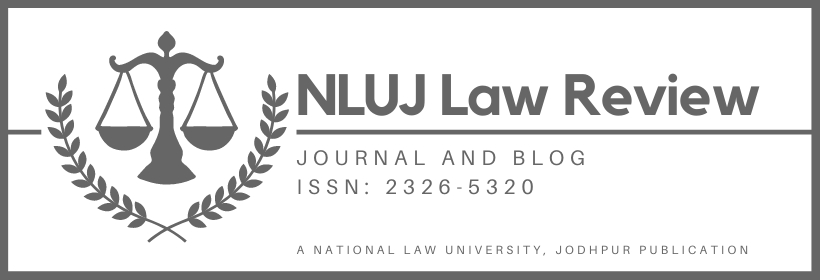The Uttar Pradesh Government recently criminalized the conversion of religion for the sake of marriage by passing the Uttar Pradesh Prohibition of Unlawful Conversion of Religion Ordinance, 2020 (“Ordinance”). The Ordinance has garnered support from other States such as Himachal Pradesh and Madhya Pradesh, who have also penalised the same. These controversial ordinances have triggered several conflicts in the realm of constitutional law. The conflict the authors intend to focus on is between the State’s legitimate aim in impjlementing this piece of legislation and the fundamental right to privacy and to freely marry an individual by choice as enshrined under Article 21 of the Constitution of India (“Constitution”). The authors also touch upon the blatant violation of the right to freely practice and profess religion by the ordinance in question with little or no evidence of unlawful conversion in the state.
The doctrine of proportionality has acquired global favour as human rights and constitutional courts have increasingly utilized the doctrine for adjudicating challenges to limitations placed on fundamental rights. Jurisprudentially, ‘proportionality’ can be defined as “the set of rules determining the necessary and sufficient conditions for limitation of a constitutionally protected right by law to be constitutionally permissible.” The idea that a measure restricting the enjoyment of fundamental rights was to be proportional to the fundamental right in question was very much prevalent during the initial stages of constitutional thought in India. However, a comprehensive utilization of the doctrine in terms of adopting a structured test by the Indian courts was not seen until the case of Modern Dental College and Research Centre v. State of Madhya Pradesh.
In this blog, the authors analyze the ordinance in light of the doctrine of proportionality.
Proportionality between religious conversion and privacy
The Ordinance pierces the private institution of marriage by requiring the parties involved to refrain from undergoing conversion by marriage. However, in this segment, we restrict ourselves to the issue of privacy. Section 8 of the Ordinance requires an individual to submit a declaration sixty days in advance to the District Magistrate or Additional District Magistrate (as empowered by the former) that he/she wishes to convert his/her religion by free choice. This is a serious constitutional concern. The right to privacy and freedom of conscience resonates in Article 21 and 25 of the Constitution, respectively. With the Allahabad High Court rejecting mandatory publication of notice to invite objections under the Special Marriage Act, the legal position is rightly inclined towards the protection of privacy in contrast to the societal interest in the private act. However, by mandating declaration, the State is potentially deploying unreasonable procedures to impinge on inter-faith marriages. For now, inter-faith marriages face significant surveillance, and in the presence of a requirement for declaration, the police can prevent solemnization of such marriages.
The ultimate stab to the right to privacy is clause 3 of Section 8 which authorizes the District Magistrate to conduct an inquiry through the police to discern ‘the real intention and purpose’ behind the conversion. As rightly held by the Supreme Court in Shafin Jahan v. Asokan K.M., the social values and morals have their space but they are not above the constitutionally guaranteed freedom. To have the freedom to choose one’s faith is essential to one’s autonomy, and such a guaranteed freedom strengthens the core norms of the Constitution. In our constitutional democracy governed by the rule of law, police cannot be authorized to violate the private spheres of individuals, especially in an attempt to discern the reason behind exercising the Constitutionally protected individual autonomy to conscience and religion. By legitimizing their power to infringe upon one’s privacy to adopt the religion of his/her spouse upon one’s volition (a protected freedom under Article 21 vis-à-vis Article 25) under the pretext of discerning the cause behind the conversion, the Ordinance paves way for an arbitrary encroachment on the individuals’ fundamental right to privacy. Therefore, the clause 3 is in absolute derogation to the fundamental rights of the individuals as mentioned herein.
In K.S. Puttuswamy v. Union of India, the guidelines provided by the Supreme Court to test infringement of the right to privacy by proportionality in paragraph 325 are “A law which encroaches upon privacy will have to withstand the touchstone of permissible restrictions on fundamental rights. In the context of Article 21, an invasion of privacy must be justified based on a law that stipulates a procedure that is fair, just, and reasonable. An invasion of life or personal liberty must meet the threefold requirement of (i) legality, which postulates the existence of law; (ii) need, defined in terms of a legitimate State aim; and (iii) proportionality which ensures a rational nexus between the objects and the means adopted to achieve them.”
Therefore, based on the above test, we argue that firstly, the ordinance is unconstitutional as it not only violates the fundamental right to privacy but also arbitrarily infringes the fundamental right of the individuals to practice and profess a faith of their own choice as enshrined under Article 25. Secondly, there is no evidence on record to establish the legitimacy of the State aim in curbing ‘conversion by marriage’ by terming it unlawful unless the converting person freely provides that such conversion is not upon their volition. It is argued that without a legitimate State aim that overpowers individual liberty to adopt a religion of his/her choice and subsequently choose a partner, the Ordinance so passed is manifestly arbitrary and therefore, unconstitutional. Thirdly, it is argued that the means adopted to fulfil the unconstitutional aim is also an encroachment into the personal lives of individuals. The means ensure that any conversion of religion undergoes a strict investigation, thereby obstructing the liberty of the individuals, and the object ultimately curbs couples from consensually converting their religion(s) through marriage.
Proportionality between religious conversion and the right to convert by marriage
Section 3 of the Ordinance prohibits any person to convert or attempt to convert “either directly or otherwise” any other person from one religion to another by marriage amidst other grounds. The Section is vaguely drafted and confers unguided power to the administration to prohibit couples from consensually marrying after a voluntary religious conversion. This is primarily because it gives wide scope to the administration to intrude upon one’s fundamental right to choose a partner when they have not registered according to the terms of the UP Ordinance. This is evident from a wedding being disrupted in Uttar Pradesh within a week of promulgation of the Ordinance. The inter-faith couple were freely exercising their right and were in fact supported by their parents. However, since the Ordinance requires a declaration and a subsequent investigation, the marriage had to be deferred until they complied with it or the Special Marriage Act.
Furthermore, Section 4 of the Ordinance authorizes any aggrieved person, his/her parents, or any other person related by blood to file an FIR when one contravenes the abovementioned Section 3. It is argued that the Section not only transcends societal morality over constitutional morality in contradiction to the Supreme Court’s dicta in Navtej Singh Johar v. Union of India, but is also against the ruling of the Supreme Court’s progressive observations in Shakti Vahini v. Union of India. In Shakti Vahini, the Supreme Court held that when two adults consensually choose each other as life partners, it is a manifestation of their choice which is recognized under Articles 19 and 21 of the Constitution. It further held that the consent of family or community or clan is not necessary when two adults agree to enter into wedlock. However, the Ordinance carves out an exception to this fundamental freedom which is disproportionate to the fulfilment of the very right.
As observed in Modern Dental College v. State of Madhya Pradesh and reiterated in Anuradha Bhasin v. Union India, for a limitation of a constitutional right to be constitutionally permissible, there needs to be proportionality stricto sensu between the importance of achieving the proper purpose and the societal importance of preventing the limitation on the constitutional right. There is and cannot be a legitimate State aim in disallowing conversion by marriage as it is a quintessential concomitant of an individual’s autonomy embedded in Article 19 and Article 21 of the Constitution. Although, the doctrine has not been consistently used by Indian courts in terms of ascertaining the gravity of the right infringing measure in proportion to the necessity of protection of such a right in question. If the courts in this case were to follow the high scrutiny and evidentiary value approach involving the substantive components of the said test, the legitimate aim in this case would fall short of requisite evidence needed to limit the fundamental right of privacy, right to individual liberty and the right to marry a person of one’s own choice.
Although nearly forty-five years ago, a Constitution Bench of the Supreme Court upheld the Madhya Pradesh and Orissa Freedom of Religion Acts by widely interpreting ‘public order’ in search of legislative competence, the acts therein did not prohibit ‘conversion by marriage’ and thus, the ruling of the 5-judge bench is not only irrelevant to resolve the impending constitutional infringement but is also weakened by the progressive rulings of the Supreme Court as discussed above. Moreover, an interfaith couple in a recent case before the Allahabad High Court sought to quash an FIR filed against them under Section 366 of the Indian Penal Code, 1860 dealing with abduction of a woman against her will with an intent to marry her. The Court in this case adopted a progressive approach in upholding the nexus between privacy, liberty and the right to choose a life partner while overruling judgements that had overlooked this nexus. This is particularly an interesting development as the Chief Minister of Uttar Pradesh had referred to these judgements in forming the basis for the Ordinance while defending it.
Conclusion
Based on the importance given to individual liberty and privacy in the precedents mentioned above, it is now clear that right to marry a person of one’s own choice, right to privacy are fundamental freedoms that cannot be restricted disproportionately by the State and its instrumentalities. The judgment of the Allahabad High Court in Safiya Sultana v. the State of U.P. is reassuring of this position, as it held that if publication of notice under the Special Marriage Act, 1954 inviting objections to the marriage were to be mandatory, they would invade the fundamental rights of liberty and privacy, including within its sphere the freedom to choose for marriage without interference from state and non-state actors. It will be interesting to observe whether the courts follow the landmark precedents in dealing with the petitions challenging the ordinance(s) and protect the constitutional morality from being trammelled by apparent societal morality.
This article has been written by Saikishan B Rathore and Prathiksha Chandrasekhar, students at Gujarat National Law University, and School of Law, Christ University, respectively.



